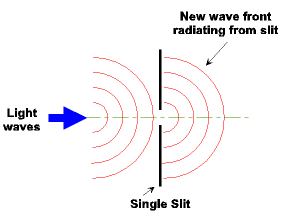[/caption]
For some time, the behavior of light has baffled scientists. Initially, and in accordance with classic physics, light was thought to be a wave, an indefinable form of energy that simply flowed from a heated source. However, with the advent of quantum physics, scientists came to realize that photons, a tiny elementary particle responsible for all forms of electromagnetic radiation, was in fact the source. So you can imagine how confounded they were when, in the course of performing experiments, they discovered that it exhibited the behavior of both a particle and a wave! This rather unique behavior, the ability of light to behave as a wave, even though it is made up of tiny particles, is known as the Diffraction of Light.
By definition, diffraction refers to the apparent bending of waves around small obstacles and the spreading out of waves past small openings. It had long been understood that this is what happens when a wave encounters an obstacle, and by the 17th and 18th centuries, this behavior was observed through experiments involving light. One such physicist who observed this at work was Thomas Young (1773 – 1829), an English polymath who is credited devised the double-slit experiment. In this experiment, Young shone a monochromatic light source (i.e. light of a single color) through an aperture (in this case, a wall with a horizontal slits cut in it) and measured the results on a screen located on the other side. The results were interesting, to say the least. Instead of appearing in the same relative shape as the aperture, the light appeared to be diffracting, implying that it was made up of waves. The experiment was even more interesting when a second slit was cut into the screen (hence the name double-slit). Young, and those who repeated the experiment, found that interference waves resulted, meaning that two propagation waves occurred which then began to interfere with one another.
A more common example comes to us in the form of shadows. Ever notice how the outer edges do not appear solid, but slightly fuzzy instead? This occurs as a result of light bending slightly as it passes around the edge of an object, again, consistent with the behavior of a wave. Similar effects occur when light waves travel through a medium with a varying refractive index, resulting in a spectrum of color or a distorted image. Since all physical objects have wave-like properties at the atomic level, diffraction can be studied in accordance with the principles of quantum mechanics.
We have written many articles about diffraction of light for Universe Today. Here’s an article about visible light, and here’s an article about telescope resolution.
If you’d like more info on diffraction of light, check out these articles:
The Physics of Light: Diffraction
Experiments on Diffraction of Light
We’ve also recorded an episode of Astronomy Cast all about the Hubble Space Telescope. Listen here, Episode 88: The Hubble Space Telescope.
Sources:
http://en.wikipedia.org/wiki/Photon
http://en.wikipedia.org/wiki/Diffraction
http://en.wikipedia.org/wiki/Double-slit_experiment
http://library.thinkquest.org/27356/p_diffraction.htm
http://en.wikipedia.org/wiki/Thomas_Young_%28scientist%29
http://ww2010.atmos.uiuc.edu/%28Gh%29/guides/mtr/opt/mch/diff.rxml

